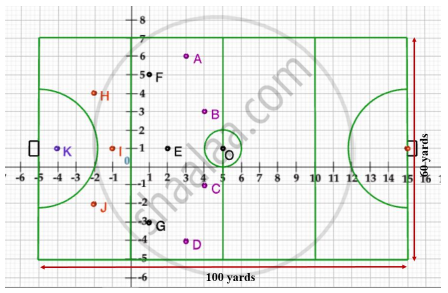Advertisements
Advertisements
प्रश्न
Name the type of quadrilateral formed, if any, by the following point, and give reasons for your answer:
(4, 5), (7, 6), (4, 3), (1, 2)
उत्तर
Let the points (4, 5), (7, 6), (4, 3), and (1, 2) be representing the vertices A, B, C, and D of the given quadrilateral respectively.
∴ AB = `sqrt((4-7)^2+(5-6)^2)`
= `sqrt((-3)^2+(-1)^2)`
= `sqrt(9+1)`
= `sqrt10`
BC = `sqrt((7-4)^2+(6-3)^2)`
= `sqrt((3)^2+(3)^2)`
= `sqrt(9+9)`
= `sqrt18`
CD = `sqrt((4-1)^2+(3-2)^2)`
= `sqrt((3)^2+(1)^2)`
= `sqrt(9+1)`
= `sqrt10`
AD = `sqrt((4-1)^2+(5-2)^2)`
= `sqrt((3)^2+(3)^2)`
= `sqrt(9+9)`
= `sqrt18`
Diagonal AC = `sqrt((4-4)^2+(5-3)^2)`
= `sqrt((0)^2+(2)^2)`
= `sqrt(0+4)`
= 2
Diagonal CD = `sqrt((7-1)^2 + (6-2)^2)`
= `sqrt((6)^2+(4)^2)`
= `sqrt(36+16)`
= `sqrt52`
= `13sqrt2`
It can be observed that opposite sides of this quadrilateral are of the same length. However, the diagonals are of different lengths. Therefore, the given points are the vertices of a parallelogram.
APPEARS IN
संबंधित प्रश्न
Find the point on the x-axis which is equidistant from (2, -5) and (-2, 9).
Show that the points A (1, −2), B (3, 6), C (5, 10) and D (3, 2) are the vertices of a parallelogram.
Show that the quadrilateral whose vertices are (2, −1), (3, 4) (−2, 3) and (−3,−2) is a rhombus.
Find the distance between the points
(ii) A(7,-4)and B(-5,1)
Using the distance formula, show that the given points are collinear:
(6, 9), (0, 1) and (-6, -7)
`" Find the distance between the points" A ((-8)/5,2) and B (2/5,2)`
Find the distance between the following pair of points.
R(0, -3), S(0, `5/2`)
Show that the ▢PQRS formed by P(2, 1), Q(–1, 3), R(–5, –3) and S(–2, –5) is a rectangle.
x (1,2),Y (3, -4) and z (5,-6) are the vertices of a triangle . Find the circumcentre and the circumradius of the triangle.
Prove that the points (0 , 0) , (3 , 2) , (7 , 7) and (4 , 5) are the vertices of a parallelogram.
Prove that the points (a, b), (a + 3, b + 4), (a − 1, b + 7) and (a − 4, b + 3) are the vertices of a parallelogram.
Find the distance between the origin and the point:
(8, -15)
A point P (2, -1) is equidistant from the points (a, 7) and (-3, a). Find a.
Calculate the distance between A (7, 3) and B on the x-axis, whose abscissa is 11.
KM is a straight line of 13 units If K has the coordinate (2, 5) and M has the coordinates (x, – 7) find the possible value of x.
Find distance between point A(– 3, 4) and origin O
Case Study -2
A hockey field is the playing surface for the game of hockey. Historically, the game was played on natural turf (grass) but nowadays it is predominantly played on an artificial turf.
It is rectangular in shape - 100 yards by 60 yards. Goals consist of two upright posts placed equidistant from the centre of the backline, joined at the top by a horizontal crossbar. The inner edges of the posts must be 3.66 metres (4 yards) apart, and the lower edge of the crossbar must be 2.14 metres (7 feet) above the ground.
Each team plays with 11 players on the field during the game including the goalie. Positions you might play include -
- Forward: As shown by players A, B, C and D.
- Midfielders: As shown by players E, F and G.
- Fullbacks: As shown by players H, I and J.
- Goalie: As shown by player K.
Using the picture of a hockey field below, answer the questions that follow:

If a player P needs to be at equal distances from A and G, such that A, P and G are in straight line, then position of P will be given by ______.
A circle has its centre at the origin and a point P(5, 0) lies on it. The point Q(6, 8) lies outside the circle.
Show that points A(–1, –1), B(0, 1), C(1, 3) are collinear.
